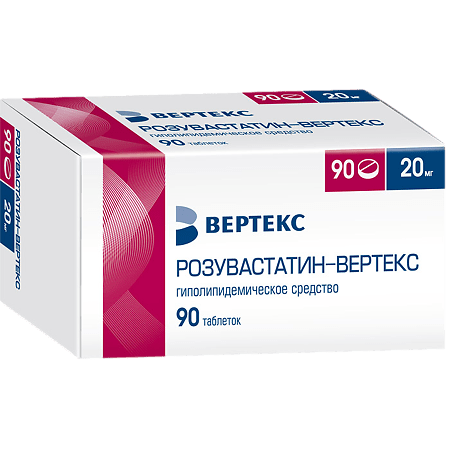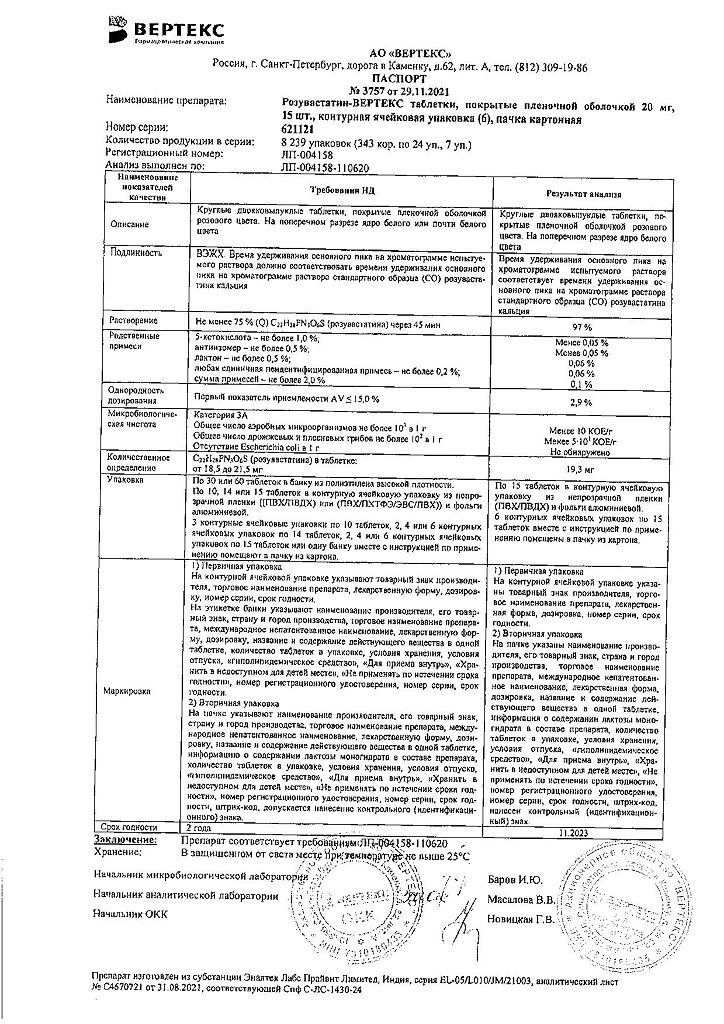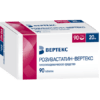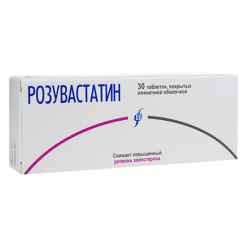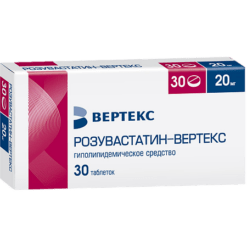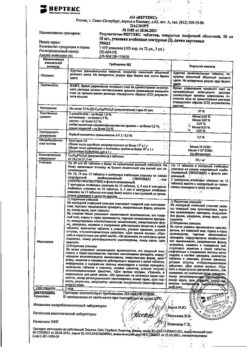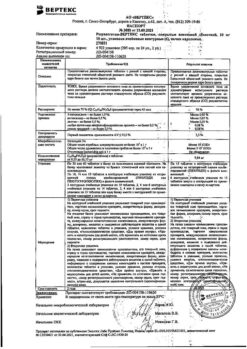No products in the cart.
Rosuvastatin-Vertex, 20 mg 90 pcs
€47.24 €40.94
Description
Rosuvastatin is a selective competitive inhibitor of HMG-CoA reductase – an enzyme that converts 3-hydroxy-3-methylglutaryl coenzyme A into mevalonic acid, cholesterol precursor.
The main target of rosuvastatin action is the liver, where the synthesis of cholesterol (Chs) and catabolism of low-density lipoprotein cholesterol (LDL-C) are performed. Rosuvastatin increases the number of X-LDL receptors on the surface of liver cells, increasing capture and catabolism of X-LDL, which in turn leads to inhibition of synthesis of very low-density lipoprotein cholesterol (VLDL), thereby reducing the total amount of X-LDL and X-LDL.
Rosuvastatin reduces elevated concentrations of Chs-LDL, total cholesterol, triglycerides (TG), increases the concentration of high-density lipoprotein cholesterol (HDL-C), and reduces the concentration of apolipoprotein B (ApoB), high-density lipoprotein cholesterol (Xs-NLDL), Xs-LDL, TG and increases the concentration of apolipoprotein A I (ApoA-I), reduces the ratio of Xs-LDL/Hs-LDL, total cholesterol/Hs-LDL and Xs-NLDL/Hs-LDL and the apoB/apoA-I ratio.
The therapeutic effect develops within one week after the start of therapy with rosuvastatin, after 2 weeks of treatment it reaches 90% of the maximum possible effect. The maximum therapeutic effect is usually achieved by the 4th week of therapy and is maintained with regular use of the drug.
Rosuvastatin is effective in adult patients with hypercholesterolemia, with or without hypertriglyceridemia, including patients with diabetes and familial hypercholesterolemia. Additive effect is observed in combination with fenofibrate (for TG concentration) and with nicotinic acid in lipid-lowering doses (for HDL-C concentration), but the possibility of such combinations should be assessed by the attending physician taking into account possible risks
Indications
Indications
– Primary hypercholesterolemia according to the Fredrickson classification (type IIa, including familial heterozygous hypercholesterolemia) or mixed hypercholesterolemia (type IIb) as an adjunct to diet when diet and other non-drug treatments (eg, exercise, weight loss) are insufficient;
Pharmacological effect
Pharmacological effect
Rosuvastatin is a selective competitive inhibitor of HMG-CoA reductase, an enzyme that converts 3-hydroxy-3-methylglutaryl coenzyme A into mevalonic acid, a cholesterol precursor.
The main target of action of rosuvastatin is the liver, where the synthesis of cholesterol (C) and the catabolism of low-density lipoprotein cholesterol (LDL-C) occurs. Rosuvastatin increases the number of LDL-C receptors on the surface of liver cells, increasing the uptake and catabolism of LDL-C, which in turn leads to inhibition of the synthesis of very low-density lipoprotein cholesterol (VLDL-C), thereby reducing the total amount of LDL-C and VLDL-C.
Rosuvastatin reduces elevated concentrations of LDL-C, total cholesterol, triglycerides (TG), increases the concentration of high-density lipoprotein cholesterol (HDL-C), and also reduces the concentration of apolipoprotein B (ApoB), non-HDL cholesterol (non-HDL-C), VLDL-C, TG and increases the concentration of apolipoprotein A I (ApoA-I), reduces the ratio LDL-C/HDL-C, total cholesterol/HDL-C and non-LDL-C/HDL-C and apoB/apoA-I ratio.
The therapeutic effect develops within one week after the start of rosuvastatin therapy, after 2 weeks of treatment it reaches 90% of the maximum possible effect. The maximum therapeutic effect is usually achieved by the 4th week of therapy and is maintained with regular use of the drug.
Rosuvastatin is effective in adult patients with hypercholesterolemia, with or without hypertriglyceridemia, including patients with diabetes mellitus and familial hypercholesterolemia.
An additive effect is observed in combination with fenofibrate (in relation to the concentration of TG) and with nicotinic acid in lipid-lowering doses (in relation to the concentration of HDL-C), however, the possibility of such combinations should be assessed by the attending physician taking into account the possible risks
Special instructions
Special instructions
Renal dysfunction. In patients receiving high doses of rosuvastatin (particularly 40 mg/day), tubular proteinuria was observed, which was detected using test strips and in most cases was intermittent or short-term.
Such proteinuria does not indicate acute illness or progression of concomitant renal disease. The incidence of serious renal dysfunction observed in post-marketing studies of rosuvastatin is higher when taking a dose of 40 mg/day.
In patients taking the drug at a dose of 30 or 40 mg/day, it is recommended to monitor kidney function indicators during treatment (at least once every 3 months). Effect on the musculoskeletal system.
The following musculoskeletal effects have been reported with rosuvastatin at all doses, but particularly at doses greater than 20 mg/day: myalgia, myopathy, and in rare cases, rhabdomyolysis.
Very rare cases of rhabdomyolysis have been reported with the simultaneous use of HMG-CoA reductase inhibitors and ezetimibe. This combination should be used with caution, because A pharmacodynamic interaction cannot be excluded. As with other HMG-CoA reductase inhibitors, the incidence of rhabdomyolysis with post-marketing use of rosuvastatin is higher when using a dose of 40 mg/day. Determination of CK activity.
CPK activity cannot be determined after intense physical activity and in the presence of other possible reasons for the increase in its activity; this may lead to incorrect interpretation of the results obtained. If the initial CPK activity is significantly exceeded (5 times higher than the ULN), a repeat analysis should be performed after 5–7 days.
Therapy cannot be started if the results of re-analysis confirm the initial high activity of CPK (more than 5 times the ULN). Before starting therapy Depending on the daily dose in patients with existing risk factors for myopathy/rhabdomyolysis, rosuvastatin is either contraindicated or should be prescribed with caution (see “Contraindications”, “Limitations on use”).
These factors include: impaired renal function; hypothyroidism; history of muscle diseases (including family); history of myotoxic effects when taking other HMG-CoA reductase inhibitors or fibrates; excessive alcohol consumption; age over 65 years; conditions in which the concentration of rosuvastatin in the blood plasma may increase; simultaneous use of fibrates.
In such patients, it is necessary to evaluate the risks and possible benefits of therapy. Clinical monitoring is also recommended. If the initial CPK activity is more than 5 times higher than the ULN, rosuvastatin therapy cannot be started.
During therapy with rosuvastatin, the patient should be informed of the need to immediately consult a doctor in case of unexpected onset of muscle pain, muscle weakness or spasms, especially in combination with malaise and fever. In such patients, CPK activity should be determined. Therapy should be discontinued if CPK activity is significantly increased (more than 5 times the ULN) or muscle symptoms are severe and cause daily discomfort (even if CPK activity is no more than 5 times the ULN).
If symptoms disappear and CPK activity returns to normal, resumption of rosuvastatin or other HMG-CoA reductase inhibitors in lower doses should be considered with close medical supervision. Monitoring CPK activity in the absence of symptoms is impractical.
Very rare cases of immune-mediated necrotizing myopathy have been reported with clinical manifestations in the form of persistent weakness of the proximal muscles and increased CPK activity in the blood serum during therapy or upon discontinuation of the use of HMG-CoA reductase inhibitors, incl. rosuvastatin.
Additional studies of the muscular and nervous system, serological studies, and therapy with immunosuppressive drugs may be required. There were no signs of increased effects on skeletal muscles when taking rosuvastatin and concomitant therapy.
However, an increase in the number of cases of myositis and myopathy has been reported in patients taking other HMG-CoA reductase inhibitors in combination with fibric acid derivatives (for example, gemfibrozil), cyclosporine, nicotinic acid in lipid-lowering doses (more than 1 g / day), azole antifungals, HIV protease inhibitors and macrolide antibiotics.
When used simultaneously with certain HMG-CoA reductase inhibitors, gemfibrozil increases the risk of developing myopathy. Therefore, the simultaneous use of rosuvastatin and gemfibrozil is not recommended. The benefits of further changes in plasma lipid concentrations when combined with fibrates or nicotinic acid at lipid-lowering doses should be carefully weighed against the potential risks.
Rosuvastatin at a dose of 30 mg/day is contraindicated for combination therapy with fibrates. Due to the increased risk of rhabdomyolysis, rosuvastatin should not be used in patients with acute conditions that may lead to myopathy, or conditions that predispose to the development of renal failure (for example, sepsis, hypotension, major surgery, trauma, severe metabolic, endocrine and electrolyte disturbances, or uncontrolled seizures).
Liver. Depending on the daily dose, rosuvastatin is contraindicated or should be used with caution in patients with excessive alcohol consumption and/or a history of liver disease (see “Contraindications”, “Limitations on use”).
It is recommended to determine liver function tests before the start of therapy and 3 months after its start. The use of rosuvastatin should be discontinued or the dose of this drug should be reduced if the activity of hepatic transaminases in the blood serum is 3 times higher than the ULN.
In patients with hypercholesterolemia due to hypothyroidism or nephrotic syndrome, underlying diseases should be treated before starting treatment with rosuvastatin. Ethnic characteristics. During pharmacokinetic studies, an increase in the plasma concentration of rosuvastatin was noted in representatives of the Mongoloid race compared to representatives of the Caucasian race. Interstitial lung disease.
Isolated cases of interstitial lung disease have been reported with the use of certain HMG-CoA reductase inhibitors, especially over long periods of time. Manifestations of the disease may include shortness of breath, non-productive cough and deterioration in general health (weakness, weight loss and fever).
If interstitial lung disease is suspected, therapy with HMG-CoA reductase inhibitors should be discontinued. Diabetes mellitus type 2. In patients with glucose concentrations from 5.6 to 6.9 mmol/l, rosuvastatin therapy was associated with an increased risk of developing type 2 diabetes mellitus. Effect on the ability to drive a car or perform work requiring an increased speed of physical and mental reactions.
Studies have not been conducted to study the effect of rosuvastatin on the ability to drive vehicles and operate machinery. However, given the possibility of developing dizziness and other side effects, caution must be exercised when driving vehicles and other mechanisms that require increased concentration and speed of psychomotor reactions.
Active ingredient
Active ingredient
Rosuvastatin
Composition
Composition
Light pink to pink film-coated tablets, round, biconvex; on a cross section – the inner layer is white or almost white.
1 tab. rosuvastatin calcium 20.84 mg, which corresponds to the content of rosuvastatin 20 mg.
Excipients:
Pregnancy
Pregnancy
Rosuvastatin is contraindicated during pregnancy and lactation. Women of reproductive age should use adequate methods of contraception. Since cholesterol and substances synthesized from cholesterol are important for the development of the fetus, the potential risk of inhibition of HMG-CoA reductase for the fetus outweighs the benefit of using rosuvastatin during pregnancy.
If pregnancy occurs during therapy, use of the drug should be discontinued immediately.
There is no data on the excretion of rosuvastatin in breast milk (it is known that other HMG-CoA reductase inhibitors can be excreted in breast milk), so use of the drug must be discontinued during breastfeeding.
FDA category of effect on the fetus is X.
Contraindications
Contraindications
Daily dose up to 30 mg: hypersensitivity to rosuvastatin; liver diseases in the active phase (including a persistent increase in the activity of liver transaminases and an increase in the activity of liver transaminases in the blood serum by more than 3 times compared to ULN); severe renal failure (Cl creatinine)
Daily dose of 30 mg or more: hypersensitivity to rosuvastatin; liver diseases in the active phase (including a persistent increase in the activity of liver transaminases and an increase in the activity of liver transaminases in the blood serum by more than 3 times compared to ULN); moderate to severe renal failure (Cl creatinine)
Side Effects
Side Effects
Side effects observed with the use of rosuvastatin are usually mild and go away on their own. As with other HMG-CoA reductase inhibitors, the incidence of side effects is mainly dose-dependent.
From the blood and lymphatic system: frequency unknown – thrombocytopenia.
From the immune system: rarely – hypersensitivity reactions, including angioedema.
From the endocrine system: often – diabetes mellitus type 2.
From the nervous system: often – headache, dizziness; very rarely – loss or decrease in memory; frequency unknown – peripheral neuropathy.
From the respiratory system, chest and mediastinal organs: frequency unknown – cough, shortness of breath.
From the digestive system: often – constipation, nausea, abdominal pain; rarely – pancreatitis; very rarely – jaundice, hepatitis; frequency unknown – diarrhea.
When using rosuvastatin, a dose-dependent increase in the activity of hepatic transaminases in the blood plasma is observed in a small number of patients. In most cases it is minor, asymptomatic and temporary.
From the skin and subcutaneous tissues: infrequently – itching, skin rash, urticaria; frequency unknown – Stevens-Johnson syndrome.
From the musculoskeletal system and connective tissue: often – myalgia; rarely – myopathy (including myositis), rhabdomyolysis (with or without acute renal failure); very rarely – arthralgia; frequency unknown – immune-mediated necrotizing myopathy.
A dose-dependent increase in CPK activity in blood plasma is observed in a small number of patients taking rosuvastatin. In most cases it is minor, asymptomatic and temporary. If CPK activity in the blood plasma increases to more than 5 times the ULN, therapy should be suspended.
From the kidneys and urinary tract: proteinuria may be detected in patients receiving rosuvastatin therapy. A change in the amount of protein in the urine (from none or trace amounts to ++ or more) is observed in less than 1% of patients receiving 10-20 mg of rosuvastatin and in about 3% of patients receiving a dose of 40 mg/day.
A slight change in the amount of protein in the urine was noted when taking a dose of 20 mg. In most cases, proteinuria decreases or disappears during therapy and does not indicate the occurrence of acute or progression of existing kidney disease; very rarely – hematuria.
From the genital organs and breast: frequency unknown – gynecomastia.
General disorders and disorders at the injection site: often – asthenic syndrome; frequency unknown – peripheral edema.
Laboratory indicators: hyperglycemia, increased concentration of bilirubin in the blood plasma, GGTP activity, alkaline phosphatase in the blood plasma, changes in the serum concentration of thyroid hormones.
The following side effects have been reported with the use of some HMG-CoA reductase inhibitors (statins): depression, sleep disturbances, including insomnia and nightmares, sexual dysfunction, increased concentrations of glycosylated hemoglobin. Isolated cases of interstitial lung disease have been reported, especially with long-term use of these drugs
Interaction
Interaction
Transport protein inhibitors: rosuvastatin binds to some transport proteins, in particular OATP1B1 and BCRP. Concomitant use of drugs that are inhibitors of these transport proteins may be accompanied by an increase in the concentration of rosuvastatin in the blood plasma and an increased risk of developing myopathy.
Cyclosporine: with simultaneous use of rosuvastatin and cyclosporine, the AUC of rosuvastatin was on average 7 times higher than the value observed in healthy volunteers. Rosuvastatin does not affect the plasma concentration of cyclosporine.
Rosuvastatin is contraindicated in patients taking cyclosporine. Human immunodeficiency virus (HIV) protease inhibitors: Although the exact mechanism of interaction is unknown, coadministration of HIV protease inhibitors with rosuvastatin may result in a significant increase in the AUC of rosuvastatin.
A pharmacokinetic study of co-administration of 20 mg rosuvastatin with a combination drug containing two HIV protease inhibitors (400 mg lopinavir/100 mg ritonavir) in healthy volunteers resulted in an increase in AUC(0-24) and Cmax of rosuvastatin by approximately 2-fold and 5-fold, respectively.
Therefore, simultaneous use of rosuvastatin and HIV protease inhibitors is not recommended. Gemfibrozil and other lipid-lowering drugs: the combined use of rosuvastatin and gemfibrozil leads to a 2-fold increase in plasma Cmax and rosuvastatin AUC (see section “Special Instructions”).
Based on specific interaction data, a pharmacokinetically significant interaction with fenofibrate is not expected, but a pharmacodynamic interaction is possible. Gemfibrozil, fenofibrate, other fibrates and lipid-lowering doses of nicotinic acid (more than 1 g/day) increased the risk of myopathy when used concomitantly with HMG-CoA reductase inhibitors, possibly due to the fact that they can cause myopathy when used as monotherapy (see section “Special Instructions”).
When taking the drug Rosuvastatin simultaneously with gemfibrozil, fibrates, nicotinic acid in lipid-lowering doses (more than 1 g/day), an initial dose of the drug of 5 mg is recommended for patients; administration at a dose of 40 mg is contraindicated when co-administered with fibrates. Ezetimibe: Concomitant use of rosuvastatin 10 mg and ezetimibe 10 mg was associated with an increase in rosuvastatin AUC in patients with hypercholesterolemia (see table).
An increased risk of side effects due to the pharmacodynamic interaction between Rosuvastatin and ezetimibe cannot be excluded. Antacids: simultaneous use of rosuvastatin and antacid suspensions containing aluminum and magnesium hydroxide leads to a decrease in the plasma concentration of rosuvastatin by approximately 50%.
This effect is less pronounced if antacids are used 2 hours after taking rosuvastatin. The clinical significance of this interaction has not been studied. Erythromycin: simultaneous use of rosuvastatin and erythromycin leads to a decrease in AUC of rosuvastatin by 20% and Cmax of rosuvastatin by 30%.
This interaction may occur as a result of increased intestinal motility caused by erythromycin. Isoenzymes of the cytochrome P450 system: the results of in vivo and in vitro studies showed that rosuvastatin is neither an inhibitor nor an inducer of isoenzymes of the cytochrome P450 system. In addition, rosuvastatin is a weak substrate for these isoenzymes.
Therefore, interaction of rosuvastatin with other drugs at the metabolic level involving isoenzymes of the cytochrome P450 system is not expected. There was no clinically significant interaction of rosuvastatin with fluconazole (an inhibitor of the CYP2C9 and CYP3A4 isoenzymes) and ketoconazole (an inhibitor of the CYP2A6 and CYP3A4 isoenzymes).
Fusidic acid: No studies have been conducted to study the interaction of rosuvastatin and fusidic acid. As with other statins, there have been post-marketing reports of rhabdomyolysis with co-administration of rosuvastatin and fusidic acid. Patients must be closely monitored. If necessary, it is possible to temporarily stop taking Rosuvastatin.
Overdose
Overdose
Symptoms: the clinical picture of overdose has not been described. When taking several daily doses at a time, the pharmacokinetic parameters of rosuvastatin do not change.
Treatment: symptomatic, monitoring of liver function and CPK activity is necessary; There is no specific antidote, hemodialysis is ineffective.
Recommendations for use
Recommendations for use
Inside, do not chew or crush the tablet, swallow it whole with water. The drug can be prescribed at any time of the day, regardless of meal time. Before starting therapy with Rosuvastatin, the patient should begin following a standard cholesterol-lowering diet and continue to follow it during treatment.
The dose of the drug should be individualized depending on the goals of therapy and the therapeutic response to treatment, taking into account current recommendations for target lipid concentrations.
The recommended initial dose for patients starting to take the drug, or for patients transferred from taking other HMG-CoA reductase inhibitors, should be 5 or 10 mg of Rosuvastatin 1 time / day. When choosing an initial dose, one should be guided by individual cholesterol levels and take into account the possible risk of cardiovascular complications, and the potential risk of side effects should be assessed. If necessary, the dose can be increased to a higher dose after 4 weeks.
Due to the possible development of side effects when taking a dose of 40 mg, compared with lower doses of the drug (see section “Side effects”), increasing the dose to 40 mg, after an additional dose above the recommended initial dose for 4 weeks of therapy, can only be carried out in patients with severe hypercholesterolemia and at high risk of cardiovascular complications (especially in patients with familial hypercholesterolemia), who have not achieved the desired result of therapy when taking a dose of 20 mg, and which will be under the supervision of a specialist.
Particularly careful monitoring of patients receiving the drug at a dose of 40 mg is recommended. It is not recommended to prescribe a dose of 40 mg to patients who have not previously consulted a doctor. After 2-4 weeks of therapy and/or when increasing the dose of Rosuvastatin, monitoring of lipid metabolism is necessary (dose adjustment is required if necessary).
The use of the drug at a higher dose than 40 mg is not justified due to increased side effects and is not recommended in most cases.
Elderly patients
No dose adjustment required.
Patients with renal failure
No dosage adjustment is required in patients with mild or moderate renal impairment. In patients with severe renal failure (creatinine clearance less than 30 ml/min.), the use of Rosuvastatin is contraindicated.
The use of the drug at a dose of 40 mg is contraindicated in patients with moderate renal impairment (creatinine clearance 30-60 ml/min)
For patients with moderate renal impairment, an initial dose of 5 mg is recommended.
Patients with liver failure
Rosuvastatin is contraindicated in patients with active liver disease. Special populations. Ethnic groups When studying the pharmacokinetic parameters of rosuvastatin in patients belonging to different ethnic groups, an increase in the systemic concentration of rosuvastatin was noted among the Japanese and Chinese (see section “Special Instructions”). This fact should be taken into account when prescribing Rosuvastatin to these groups of patients.
When prescribing doses of 10 and 20 mg, the recommended starting dose for patients of the Mongoloid race is 5 mg. Prescribing the drug at a dose of 40 mg is contraindicated for patients of the Mongoloid race (see section “Contraindications”).
Genetic polymorphism
Carriers of the SLCO1B1 (OATP1B1) c.521CC and ABCG2 (BCRP) c.421AA genotypes showed an increase in exposure (AUC) to rosuvastatin compared to carriers of the SLCO1B1 c.521TT and ABCG2 c.421CC genotypes. For patients carrying genotypes c.521CC or c.421AA, the recommended maximum dose of Rosuvastatin is 20 mg 1 time / day.
Patients predisposed to myopathy
Prescribing the drug at a dose of 40 mg is contraindicated in patients with factors that may indicate a predisposition to the development of myopathy. When prescribing doses of 10 and 20 mg, the recommended starting dose for this group of patients is 5 mg
Concomitant therapy
Rosuvastatin binds to various transport proteins (in particular, OATP1B1 and BCRP). When co-administering Rosuvastatin with drugs (such as cyclosporine, some HIV protease inhibitors, including the combination of ritonavir with atazanavir, lopinavir and/or tipranavir) that increase the plasma concentration of rosuvastatin due to interaction with transport proteins, the risk of myopathy (including rhabdomyolysis) may increase.
In such cases, the possibility of prescribing alternative therapy or temporarily stopping the use of Rosuvastatin should be assessed. If the use of the above drugs is necessary, the benefit-risk ratio of concomitant therapy with Rosuvastatin should be assessed and the possibility of reducing its dose should be considered.
Storage conditions
Storage conditions
Store in a place protected from light at a temperature not exceeding 25 °C.
Shelf life
Shelf life
2 years
Manufacturer
Manufacturer
Vertex, Russia
Additional information
| Shelf life | 2 years |
|---|---|
| Conditions of storage | Store in the dark place at a temperature not exceeding 25 ° C. |
| Manufacturer | Vertex, Russia |
| Medication form | pills |
| Brand | Vertex |
Other forms…
Related products
Buy Rosuvastatin-Vertex, 20 mg 90 pcs with delivery to USA, UK, Europe and over 120 other countries.

